The strength of the electrostatic field of a system of point charges is equal to the vector sum of the field strengths created by each charge separately
tension electrostatic field. Field strength of a point charge and system point charges. The principle of imposing fields.
Electric field is created by electric charges or simply charged bodies, and also acts on these objects, regardless of whether they are moving or stationary. If electrically charged bodies are motionless in a given reference frame, then their interaction is carried out by means of an electrostatic field. The forces acting on charges (charged particles) from an electrostatic field are called electrostatic forces.
Quantitative characteristic power action electric field on charged particles and bodies is the vector quantity E, called the electric field strength.
Consider the charge q as a "source" of the electric field, in which a unit test charge q / =+1 is placed at a distance r, i.e. a charge that does not cause a redistribution of the charges that create the field. Then, according to Coulomb's law, a force will act on the trial charge
Consequently, electrostatic field strength vector at this point numerically equal to strength , acting on a trial unit positive charge q / placed at this point of the field
where – radius - a vector drawn from a point charge to the investigated point of the field. The unit of tension is = / . The tension is directed along a radius - a vector drawn from the point where the charge is located, to point A (away from the charge, if the charge is positive, and towards the charge - if the charge is negative).
An electric field is called homogeneous if its intensity vector is the same at all points of the field, i.e. coincides both in modulus and in direction. Examples of such fields are the electrostatic fields of a uniformly charged infinite plane and a flat capacitor far from the edges of its plates. For graphic image electrostatic field use lines of force ( tension lines) - imaginary lines, the tangents to which coincide with the direction of the intensity vector at each point of the field (Fig. 10.4. - shown by solid lines). The density of lines is determined by the modulus of tension at a given point in space.
Tension lines are open - they start on positive and end on negative charges. The lines of force do not intersect anywhere, since at each point of the field its intensity has one single value and a certain direction.
Consider the electric field of two point charges q 1 and q2 .
Let be the field strength at the point a, created by the charge q 1(without taking into account the second charge), and - the field strength of the charge q 2 (without taking into account the first charge). The strength of the resulting field (in the presence of both charges) can be found by the rule of addition of vectors (by the parallelogram rule, Fig. 10.5).
The strength of the electric field from several charges is principle of superposition of electrostatic fields, according to which the tension of the resulting field created by the system of charges is equal to the geometric sum of the field strengths created at a given point by each of the charges separately.
The principle of superposition is applied in the calculation of fields created by discrete charges, such as a dipole.
An electric dipole is a system of two equal in magnitude and opposite in sign charges + Q and - Q (Figure 4).
The straight line passing through both charges is called the axis of the dipole. Vector drawn from negative charge to the positive is called the shoulder of the dipole.
The calculation of the field strength at an arbitrary point C is rather complicated. In practice, it is most often necessary to calculate the strength on the dipole axis and on the perpendicular to the axis, restored to the center of the dipole at a distance from the center r.
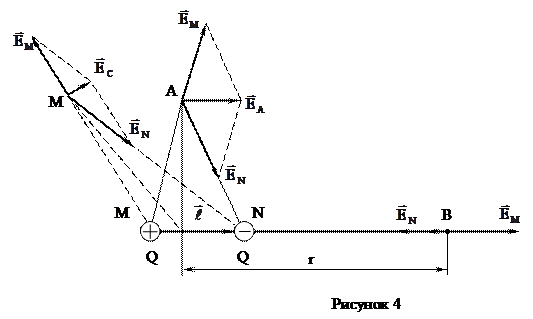 |
At points located on the axis of the dipole, or ![]() The strengths E M and E N are determined by the formulas
The strengths E M and E N are determined by the formulas

 .
.
 .
.
If , then ![]() , where - electric moment dipole.
, where - electric moment dipole.
At points, on a straight line passing through the center of the dipole perpendicular to its axis, the intensity is equal to vector sum and , and For distances AM = r and AN = r , then from the similarity of triangles AE M E N and MAN we obtain
![]()
An example of a dipole is, for example, a polarized molecule. The behavior of electric dipoles determines the properties of dielectrics, which will be discussed later.
End of work -
This topic belongs to:
ELECTROSTATIC FIELD
Physical and Chemical properties substances from the atom to the living cell are largely explained electrical forces Electrical... Electrostatic... Example Medium e Vacuum Air Kerosene Water...
If you need additional material on this topic, or you did not find what you were looking for, we recommend using the search in our database of works:
What will we do with the received material:
If this material turned out to be useful for you, you can save it to your page on social networks:
| tweet |
All topics in this section:
Heterogeneous chains
Electrical circuit, in which the continuous flow of current is ensured by external forces, is called n
MAGNETIC FIELD IN VACUUM
An electrostatic field arises near stationary charges. The movement of charges (flow electric current) leads to the appearance new form matter - magnetic field. This is a person
Circulation of the magnetic induction vector
By analogy with electrostatics, the concept of vector circulation in a closed loop is defined
Circuit with current in a uniform magnetic field
Let's apply Ampère's law to a rectangular circuit with current in a uniform magnetic field. Edges “a” are subjected to a force
Circuit with current in a non-uniform magnetic field
If a current-carrying circuit is in a non-uniform magnetic field, then unequal forces act on its different sections
Circuit with current in a radial magnetic field
From formulas (37) and (38) it follows that in a uniform magnetic field, the torque acting on the current-carrying circuit is maximum if
Electric motors
From Figure 23 it follows that with the chosen orientation of the magnet poles and the direction of the current in the circuit, the torque is directed “on us”, that is, it tends to turn the circuit counterclockwise
The work of the magnetic field
If the ampere force acting on a current-carrying conductor from the magnetic field causes it to move, then o
Magnetization of substances
Various substances in a magnetic field, they become magnetized, that is, they acquire a magnetic moment and themselves become sources of magnetic fields. The resulting magnetic field in the medium is the sum of the fields,
Dia-, para- and ferromagnets and their application.
The magnetic moment of an atom includes several components, where
Diamagnets
Some atoms (Cu, Au, Zn, etc.) electron shells have such a structure that the orbital and spin moments are mutually compensated, and in general the magnetic moment of the atom is equal to n
Paramagnets
Atoms of substances such as Al, Mn, Os, etc. have an uncompensated total orbital moment, that is, in the absence of an external field, they have their own magnetic moments. thermal
Ferromagnets and their applications
Substances whose magnetic permeability reaches hundreds and even millions of units are isolated
ELECTROMAGNETIC INDUCTION
At the core modern way electricity generation lies physical phenomenon electromagnetic induction, discovered by Faraday in 1831. Modern energy is increasingly
The phenomenon of electromagnetic induction
Consider the essence of electromagnetic induction and the principles that lead to this phenomenon. Suppose that conductor 1-2 moves in a magnetic field with a speed
Electric generator
Faraday's law refers to the fundamental laws of nature, and is a consequence of the law of conservation of energy. It is widely used in engineering, in particular, in generators. Main hour
self induction
The phenomenon of electromagnetic induction is observed in all cases when the magnetic flux penetrating the circuit changes. In particular, the magnetic flux is also created by the current flowing in the circuit itself. Poeto
Transient processes in circuits with inductance
Consider a circuit containing an inductance and active resistance(Figure 44). In the initial state, the key S was in the neutral position. Let at time t
Mutual induction. Transformer
The phenomenon of mutual induction is special case phenomena of electromagnetic induction. Let's put two horses
MAXWELL EQUATIONS
By the middle of the 19th century, a large number of experimental facts on electricity and magnetism had been accumulated. An invaluable contribution to this was made by M. Faraday, whose crowning success
Magnetic field energy
Let's calculate the energy of the magnetic field. To do this, we calculate the work of the current source in a circuit with inductance. When the current is established in such a circuit according to Ohm's law, we have iR = ε
Vortex electric field
In accordance with Faraday's law for electromagnetic induction, in a circuit that moves in a magnetic field, an emf arises proportional to the rate of change magnetic flux in e
Bias current
In accordance with the direct hypothesis of J. Maxwell, a changing magnetic field generates an alternating electric field. Maxwell's inverse hypothesis states that the variable electric
Maxwell's equations
In 1860-65. Maxwell developed the theory of unity electromagnetic field, which is described by the system of Maxwell equations
Measured with test charge q n. How will the tension modulus change if the value of the test charge is doubled?
#Will not change #Increase by 2 times #Decrease by 2 times #Increase by 4 times
Task 2. Complexity 1
How will the strength of the electric field created by a point charge change when the distance from it doubles?
#Will not change #Decrease by 2 times #Decrease by 4 times #Decrease by 16 times
Task 3. Complexity 1
Which of the following formulas is the definition of the electric field strength?
; 
#Both formulas #Only the first #Only the second #None of them
Task 4. Complexity 1
What is the direction at the point O has the electric field strength vector created by two similar charges?
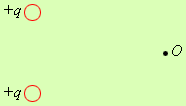
#left #right #up #down
Task 5. Complexity 2
M from her distance r d between the charges of the dipole is considered to be much smaller than the distance r to the point M.

#E M~1/ r 4 #E M~1/ r 3 . #E M~1/ r 2 . #E M~1/ r. #Tension E M does not depend on r
Task 6. Complexity 2
How does the field strength at a point M from distance r to the center of the dipole (see Fig.)? Distance d between the charges of the dipole is much less than the distance r.

#E M~1/ r 4 #E M~1/ r 3 . #E M~1/ r 2 . #E M~1/ r. #Tension E M does not depend on r
Task 7. Complexity 2
How does the electric field strength of an infinite uniformly charged plane depend on the distance R to the plane?
#E ~ 1/r 3 . #E ~ 1/r 2 . #E ~ 1/r. #Tension does not depend on the distance to the plane
Task 8. Complexity 2
point charge +q +q outside the sphere, then the flow of the electrostatic field strength vector through the surface ...
Task 9. Complexity 2
point charge +q is at the center of a spherical surface. If we increase the radius of the spherical surface, then the flow of the electrostatic field strength vector through the surface ...
# will not change # will increase # will decrease
Problem 10. Complexity 2
point charge +q is at the center of a spherical surface. If we decrease the radius of the spherical surface, then the flow of the electrostatic field strength vector through the surface ...
# will not change # will increase # will decrease
Problem 11. Complexity 2
A point charge +q is at the center of a spherical surface. If the charge is displaced from the center of the sphere, leaving it inside it, then the flow of the electrostatic field strength vector through the surface ...
# will not change # will increase # will decrease
Problem 12. Complexity 2
point charge +q is at the center of a spherical surface. If you add a charge +q
# will increase # will decrease # will not change
Problem 13. Complexity 2
point charge +q is at the center of a spherical surface. If you add a charge -q inside the sphere, then the flow of the electrostatic field strength vector through the surface ...
# will decrease # will increase # will not change
Problem 14. Complexity 1
The modulus of the intensity of a uniform electric field inside a flat capacitor is ... if the voltage on its plates is 10 V, and the distance between the plates is 5 mm?
#2000; #2; #0,5; #50.
Problem 15. Complexity 2
The modulus of the interaction force between two identical point charges of 3 μC each, located in vacuum, is 100 mN. Then the distance between is ... .
#0,9; #0,81; #81; #90.
Problem 16. Complexity 1
![]() FROM equals a FROM oriented towards...
FROM equals a FROM oriented towards...

Problem 17. Complexity 1
The electric field is created by point charges of the same magnitude and . If a q 1 = - q, q 2 = + q, and the distance between the charges and from to the point FROM equals a, then the field strength vector at the point FROM oriented towards...
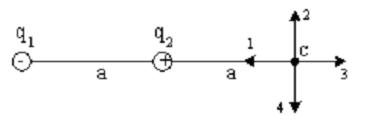
Problem 18. Complexity 2
zero through…

#surface ; #surfaces ; #surface ; #surface .
Problem 19. Complexity 2
A system of point charges in vacuum and closed surfaces are given. Electrostatic field strength vector flow zero across surfaces...
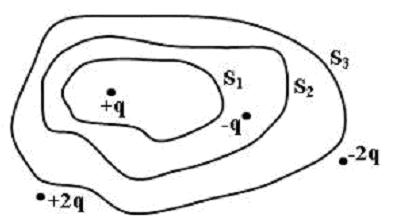
#surface #surface #surface .
Answer: 2.3.
Problem 20. Complexity 1
On a conducting sphere with a radius of 40 cm there is a charge of 0.1 μC. The modulus of the electric field strength at a distance of 0.6 m from the surface of the sphere is ....
#300; #600; #900; #1200.
Problem 21. Complexity 1
A flat capacitor was charged so that the field strength is 315 V/m and disconnected from the current source. The field strength modulus near one plate of this capacitor equals ... if the other plate is removed.
#0; #157,5; #315; #630.
Problem 22. Complexity 1
The electric field is created by point charges of the same magnitude q 1 and q 2 .
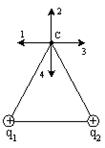
If a ![]() , and the distance between the charges and from the charges to point C is the same, then the field strength vector at point C is oriented in the direction ...
, and the distance between the charges and from the charges to point C is the same, then the field strength vector at point C is oriented in the direction ...
Problem 23. Complexity 2
Indicate which graph correctly shows the dependence of the electrostatic field strength E from distance r between the center of a uniformly charged conductive spheres with a radius R and the point where tension is determined.
# 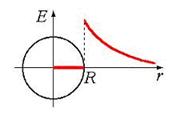 #
#  #
#  #
# 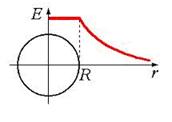
Problem 24. Complexity 2
The electric field is created by two infinite parallel planes charged with surface densities and Qualitative dependence of the projection of the field strength on the coordinate X outside the plates and between the plates reflects the graph...
#  #
#  #
#  #
# 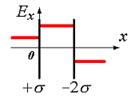
Problem 25. Complexity 1
A rigid electric dipole is in a uniform electrostatic field.

The moment of forces acting on the dipole is directed ...
#along the tension vector #away from us #against the tension vector #towards us
Problem 26. Complexity 2
The flow of the electrostatic field strength vector through a closed surface S equals...

Problem 27. Complexity 2
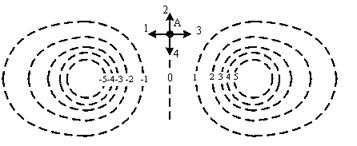
Problem 28. Complexity 2
The figure shows the equipotential lines of the system of charges and the potential values on them. The electric field strength vector at point A is oriented in the direction ...
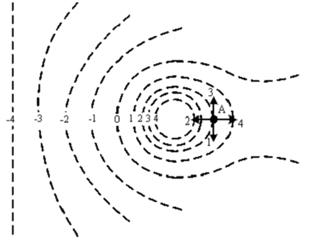
Problem 29. Complexity 1
In what area on the line connecting point charges + q and 2 q, is there a point at which the field strength is zero?

Problem 30. Complexity 1
The intensity vector of the resulting electrostatic field created by point charges of the same magnitude in the center of an equilateral triangle has the direction ...

Problem 31. Complexity 2
The strength of the electrostatic field created by point charges 2 q and - q can be zero at the point...

Problem 32. Complexity 2
The magnitude of the strength of the electrostatic field created by a uniformly charged spherical surface of radius R, depending on distance r from its center is correctly represented in the figure ...
#  # # #
# # # 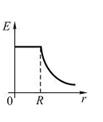
Problem 33. Complexity 1
When a dielectric is placed in an electric field, the electric field strength inside an infinite homogeneous isotropic dielectric with permittivity e...
#remains unchanged #decreases by e times #remains equal to zero #increases by e times
Problem 34. Complexity 2
The figure shows the equipotential lines of the system of charges and the potential values on them. The electric field strength vector at point A is oriented in the direction ...

Problem 35. Complexity 2
At the center of a sphere with a radius R, uniformly charged with a negative charge - q. there is a positive charge q. Distance dependence of field strength r to the center of the sphere is correctly shown in the graph...
# 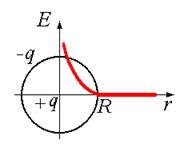 #
#  #
# 
Problem 36. Complexity 2
The dependence of the potential of the electrostatic field on the coordinate X shown in the figure.
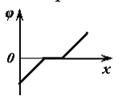
Tension vector projection E x this field depends on the coordinate X as shown in the graph...
# 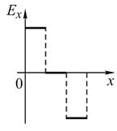 #
#  #
#  #
#
Problem 37. Complexity 1
The direction of the electric field strength vector coincides with the direction of the force acting on ...
# an uncharged metal ball placed in an electric field # a negative test charge placed in an electric field # a positive test charge placed in an electric field # no answer since the field strength is a scalar quantity
Problem 38. Complexity 1
The force acting in the field on a charge of 0.00002 C is 4 N. The field strength at this point is ...
# 200000 N/C # 0.00008 V/m # 0.00008 N/C # 5×10 -6 C/N
Problem 39. Complexity 1
For a point charge q from the side of the point charge Q force of attraction F. Charge q increase by 4 times. The strength of the field created by the charge Q, at the point in space where the charge is located q …
# will not change # will increase by 4 times # will decrease by 4 times # depends on the distance between the charges
Problem 40. Complexity 1
F. What will be the modulus of the force of interaction between bodies if the electric charge of each body is increased by n once?
# nF # n 2 F # f/n # F/n 2
Problem 41. Complexity 2
The modulus of the force of interaction between two point charged bodies is equal to F. What will be the modulus of the force of interaction between bodies if the electric charge of each body is reduced by n once?
# nF # n 2 F # f/n # F/n 2
Problem 42. Complexity 1
A conducting hollow ball with a thick shell (the figure shows the cross section of the ball) was given a positive electric charge. In what areas is the electrostatic field strength zero?
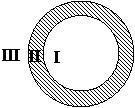
# only in I # only in II # only in III # in I and II
Problem 43. Complexity 1
Two electrical charge values 2×10 -9 CL and - 4×10 -9 CL are located at a distance of 0.1 m from each other, with the negative to the right of the positive. Where is the electric field strength directed at a point located on the line connecting the charges, 0.1 m to the right of the negative charge?
# right # left # is zero # vertically up # vertically down.
Problem 44. Complexity 3
point charge q creates at a distance R electric field strength E 1 = 62.5 V/m. Three concentric spheres with radii R, 2R and 3 R carry charges evenly distributed over their surfaces q 1 = +2q, q 2 = -q, and q 3 = +q, respectively (see Fig.). What is the field strength at the point BUT, spaced from the center of the spheres at a distance of 2.5 R?

# 5 V/m # 10 V/m # 15 V/m # 1 kV/m
Problem 45. Complexity 3
Four identical charge q located on the plane at the vertices of a square with sides L and are kept in balance by the threads connecting them in pairs (see Fig.). The repulsive force of neighboring charges ![]() N. What is the tension force T each thread?
N. What is the tension force T each thread?

# 2.7 × 10 -2 N # 3 × 10 -2 N # 1 N # 5 N
Problem 46. Complexity 1
The flow of the electric field strength vector through a spherical surface is equal to F E (F E> 0). Added a charge inside the sphere + q, a outside - -q. In this case, the flow of the electric field strength vector through a spherical surface...
#increased #did not change #decreased #became equal to zero.
Problem 47. Complexity 2
The electrostatic field is formed by two parallel infinite planes charged with opposite charges with the same surface charge density. The distance between the planes is d. Tension distribution E such a field along the axis X, perpendicular to the planes, is correctly shown in the figure ...
# 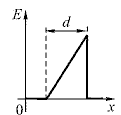 #
#  #
# 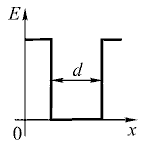 #
# 
Problem 48. Complexity 2
Two conductors made from the same material equal length, but with different sections ( S 1 > S 2) are connected in series in the circuit. Electric field strength...
#more in cross-section conductor S 1 #more in cross section conductor S 2 #same in both conductors #in a conductor with cross section S 1 can be either more or less.
Problem 49. Complexity 2
Given a system of point charges in vacuum and closed surfaces S 1 , S 2 and S 3 . If the flow of the electrostatic field strength vector through a closed surface S##
Problem 52. Complexity 2

Problem 53. Complexity 2
At the vertices of an equilateral triangle are charges of the same modulus.
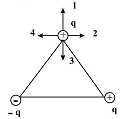
The direction of the force acting on the upper charge and the direction of the field strength at the location of this charge are indicated by the vectors: ...
Problem 54. Complexity 1
The figure shows lines of force electrostatic field. Specify the correct ratio for the magnitude of tension E fields in dots A. AT and FROM.

#E A =E C >E B # E A =E C






